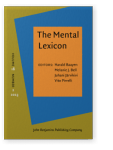Vol. 18:2 (2023) ► pp.177–217
Behavioural evidence for implicative paradigmatic relations
Form predictability has long been known to influence speaker behaviour in language learning and use. However, this observation has largely remained dissociated from the question of the most apt theoretical framing of the effects observed. We set out to seek evidence that speakers’ relationship to form predictability is best characterised in paradigmatic terms: in an experimental task comparable to prediction of one word form from a related one, speakers appear sensitive to the probabilistic, implicative relations that make up a morphological paradigm. We find this effect to be omnidirectional, from any paradigm cell to any paradigm cell. Form predictability does not impact speaker behaviour in a vacuum, but instead works together with aspects of memory and learning to organise the mental lexicon and inform language use. In a corpus study, we map out the complex relationships that exist between paradigmatic form predictability, lexeme frequency and cell frequency in the context of naturalistic language use. Speakers appear to exploit all available probabilistic relationships between the word forms of a language in a way that is predicted by Word and Paradigm theories of morphology, with memory and predictive processing playing a mediating role in all aspects of language use.
Article outline
- 1.Introduction
- 2.Background
- 2.1The implicative structure of paradigms
- 2.2Quantitatively tackling the PCFP
- 2.3Zipfian frequency distributions, discriminability and the PCFP
- 2.4Shifting the perspective: Form predictability as a paradigmatic phenomenon
- 2.5Predictions and outline
- 3.Acceptability judgement experiment
- 3.1Items
- 3.2Procedure
- 3.3Subjects
- 3.4Analysis
- Paradigmatic predictability
- Condition
- Paradigmatic predictability: Condition
- Phonological Well-formedness
- 3.5Results
- 3.6Discussion
- 4.Corpus Study
- 4.1Methodology
- 4.1.1Data selection
- 4.1.2Model structure
- Predicted variable
- Token frequency
- Predictor Variables
- Paradigmatic predictability
- Co-paradigmatic frequency
- Cell frequency
- Predicted variable
- 4.2Results
- 4.3Discussion
- 4.1Methodology
- 5.Conclusion
- Acknowledgements
- Notes
-
References
